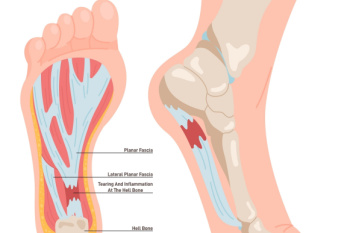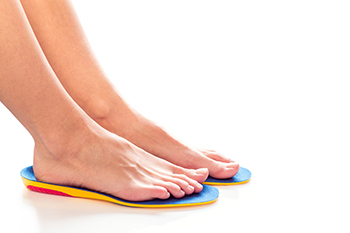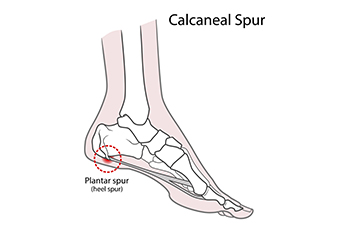
Plantar fasciitis is a painful foot condition caused by strain and inflammation of the plantar fascia. This band of tissue supports the arch and connects the heel to the front of the foot. When the plantar fascia becomes damaged, ongoing heel pain may interfere with walking or standing. When pain continues for 12 months or more despite consistent medical treatment, surgery may be considered. A podiatrist may perform a plantar fasciotomy, which involves cutting part of the fascia to relieve tension. This procedure can be done in traditional open surgery or with a less invasive endoscopic method. Recovery generally begins with limited weight-bearing, with many people walking more comfortably within a few weeks and returning to full activity within two months. While surgery for plantar fasciitis is not needed in most cases, it may help reduce long-term pain and restore foot function when other options have failed. If you have foot pain from plantar fasciitis, it is suggested that you schedule an appointment with a podiatrist to determine whether surgery is an option.
Foot surgery is sometimes necessary to treat a foot ailment. To learn more, contact one of our podiatrists of Premier Ankle & Foot Specialists. Our doctors will assist you with all of your foot and ankle needs.
When Is Surgery Necessary?
Foot and ankle surgery is generally reserved for cases in which less invasive, conservative procedures have failed to alleviate the problem. Some of the cases in which surgery may be necessary include:
- Removing foot deformities like bunions and bone spurs
- Severe arthritis that has caused bone issues
- Cosmetic reconstruction
What Types of Surgery Are There?
The type of surgery you receive will depend on the nature of the problem you have. Some of the possible surgeries include:
- Bunionectomy for painful bunions
- Surgical fusion for realignment of bones
- Neuropathy decompression surgery to treat nerve damage
Benefits of Surgery
Although surgery is usually a last resort, it can provide more complete pain relief compared to non-surgical methods and may allow you to finally resume full activity.
Surgical techniques have also become increasingly sophisticated. Techniques like endoscopic surgery allow for smaller incisions and faster recovery times.
If you have any questions please feel free to contact our offices located in South York, West York, and East York, PA . We offer the newest diagnostic and treatment technologies for all your foot and ankle needs.

Plantar heel pain is often caused by stress and inflammation in the tissues supporting the foot arch. Custom foot orthotics are uniquely designed to fit your foot's structure to provide targeted support where it is needed most. They help distribute pressure more evenly, reduce strain on the plantar fascia, and improve overall foot alignment. This can lead to lasting relief from pain and improved mobility. A podiatrist can assess the exact cause of your heel pain, take precise measurements, and create orthotics that promote healing and prevent further discomfort. Heel pain can interfere with your daily routine. If this applies to you, it is suggested that you consult a podiatrist to explore how custom orthotics can support your recovery and comfort.
Custom orthotics and shoe inserts are not just for cushioning the soles; they are about supporting the foundation of our body - our feet. The advantages extend far beyond immediate relief from discomfort. These personalized solutions, that Our doctors can prescribe, can significantly impact a person’s posture, alleviate pain in various parts of the body, and even enhance athletic performance.
As we lace up our shoes each day, having the right support can make a world of difference. Custom orthotics are like tailored suites for our feet, offering a bespoke solution to address our unique biomechanical needs. They provide stability where it is lacking, correct imbalances, and ensure that every step is a confident and pain-free one.
Custom orthotics and shoe inserts offer long-term health benefits. By addressing issues such as overpronation or underpronation, heel pain, plantar fasciitis, etc. orthotics can help prevent injuries and mitigate the progression of existing conditions. It’s an investment not just in the present, but in the future health of your feet and consequently, your overall well-being.
If you have any questions please contact our offices located in South York, West York, and East York, PA . We offer the newest diagnostic and treatment technologies for all your foot and ankle needs.

Heel spurs are bony growths that develop on the underside of the heel bone, often caused by long-term strain on foot muscles and ligaments. They are frequently associated with plantar fasciitis and may result from repeated stress, walking abnormalities, or footwear that lacks adequate support. Risk factors include obesity, flat feet, aging, and extended periods of standing or walking. Symptoms include sharp heel pain, especially with the first steps in the morning. A podiatrist can diagnose heel spurs using imaging and physical examination and may recommend treatments, such as custom orthotics, stretching exercises, or footwear changes. If heel pain is affecting your mobility, it is suggested that you consult a podiatrist to find relief and regain comfort in your daily activities.
Heel spurs can be incredibly painful and sometimes may make you unable to participate in physical activities. To get medical care for your heel spurs, contact one of our podiatrists from Premier Ankle & Foot Specialists. Our doctors will do everything possible to treat your condition.
Heels Spurs
Heel spurs are formed by calcium deposits on the back of the foot where the heel is. This can also be caused by small fragments of bone breaking off one section of the foot, attaching onto the back of the foot. Heel spurs can also be bone growth on the back of the foot and may grow in the direction of the arch of the foot.
Older individuals usually suffer from heel spurs and pain sometimes intensifies with age. One of the main condition's spurs are related to is plantar fasciitis.
Pain
The pain associated with spurs is often because of weight placed on the feet. When someone is walking, their entire weight is concentrated on the feet. Bone spurs then have the tendency to affect other bones and tissues around the foot. As the pain continues, the feet will become tender and sensitive over time.
Treatments
There are many ways to treat heel spurs. If one is suffering from heel spurs in conjunction with pain, there are several methods for healing. Medication, surgery, and herbal care are some options.
If you have any questions feel free to contact our offices located in South York, West York, and East York, PA . We offer the latest in diagnostic and treatment technology to meet your needs.

